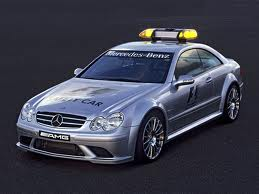 The safety car’s main function (currently a Mercedes-Benz SLS AMG – Mercedes’ cars ensure this job since 1986) is to assist in maintaining safe track conditions throughout a Grand Prix weekend. It was first introduced in 1973 and it is driven by an experienced circuit driver (for the last 11 years Bernd Mayländer) and carries an FIA observer who is in permanent radio contact with race control. If an accident or incident occurs that is not severe enough to require a race to be suspended, but which cannot be dealt with under yellow flags, then the safety car will be called on to the circuit to slow the cars down. When the order is given to deploy the safety car the message “SAFETY CAR DEPLOYED” will be displayed on the timing monitors and all marshal’s posts will display waved yellow flags and “SC” boards for the duration of the intervention.
The safety car’s main function (currently a Mercedes-Benz SLS AMG – Mercedes’ cars ensure this job since 1986) is to assist in maintaining safe track conditions throughout a Grand Prix weekend. It was first introduced in 1973 and it is driven by an experienced circuit driver (for the last 11 years Bernd Mayländer) and carries an FIA observer who is in permanent radio contact with race control. If an accident or incident occurs that is not severe enough to require a race to be suspended, but which cannot be dealt with under yellow flags, then the safety car will be called on to the circuit to slow the cars down. When the order is given to deploy the safety car the message “SAFETY CAR DEPLOYED” will be displayed on the timing monitors and all marshal’s posts will display waved yellow flags and “SC” boards for the duration of the intervention.
The safety car will come on to the circuit with its orange lights on and all drivers must form a queue behind it with no overtaking allowed. The safety car will signal backmarkers to pass by using its green light until the race leader is immediately behind it. When the safety car is ready to leave the circuit it extinguishes its orange lights, indicating to the drivers that it will peel off into the pits at the end of the current lap. The drivers then continue in formation until they cross the first safety-car line where green lights will indicate that they are free to race again.
Apart from few exceptions, such as overtaking occurring on pit lane stop, if a car slows with an obvious problem, or if the safety car signals a pilot to pass, overtaking is prohibited before crossing the first safety-car line where green lights are showed to drivers. As mentioned in the previous post on slower and overlapped cars, If the clerk of the course considers it safe to do so, and the message “LAPPED CARS MAY NOW OVERTAKE” is shown on the timing monitors, any cars that have been lapped by the leader will be required to pass the cars on the lead lap and the safety car. This will only apply to cars that were lapped at the time they crossed the line at the end of the lap during which they crossed the first safety car line for the second time after the safety car was deployed.
In exceptional circumstances, such as in extremely poor weather, a race may begin behind the safety car, which will put its orange lights on ten minutes before the start to indicate this. When those lights switch to green the safety car will lead the field around the circuit in grid order. Overtaking on this first lap is not allowed, unless a car has a problem getting away from the grid, in which case the delayed driver may repass cars in order to regain his original position. (If he fails to regain that position before the end of the lap, he must pit and rejoin the race once the pack has passed the pit exit.) The safety car will peel into the pits at the end of the lap and drivers are free to race once they have crossed the first safety car line immediately prior to commencing the next lap. No overtaking is allowed if the safety car is on track on the final lap.
All laps completed behind the safety car count as race laps.



